Springerle are German anise-flavored cookies that go back at least 700 years in their rich tradition as special gifts during the holidays and other celebrations. Delicately crispy-crunchy and a slightly chewy center, they’re made with simple ingredients and are easy to make but absolutely require that you follow some key steps to achieving the right look, texture and flavor. This authentic Springerle recipe goes back to the Swabia region of Germany where these famous cookies originated.
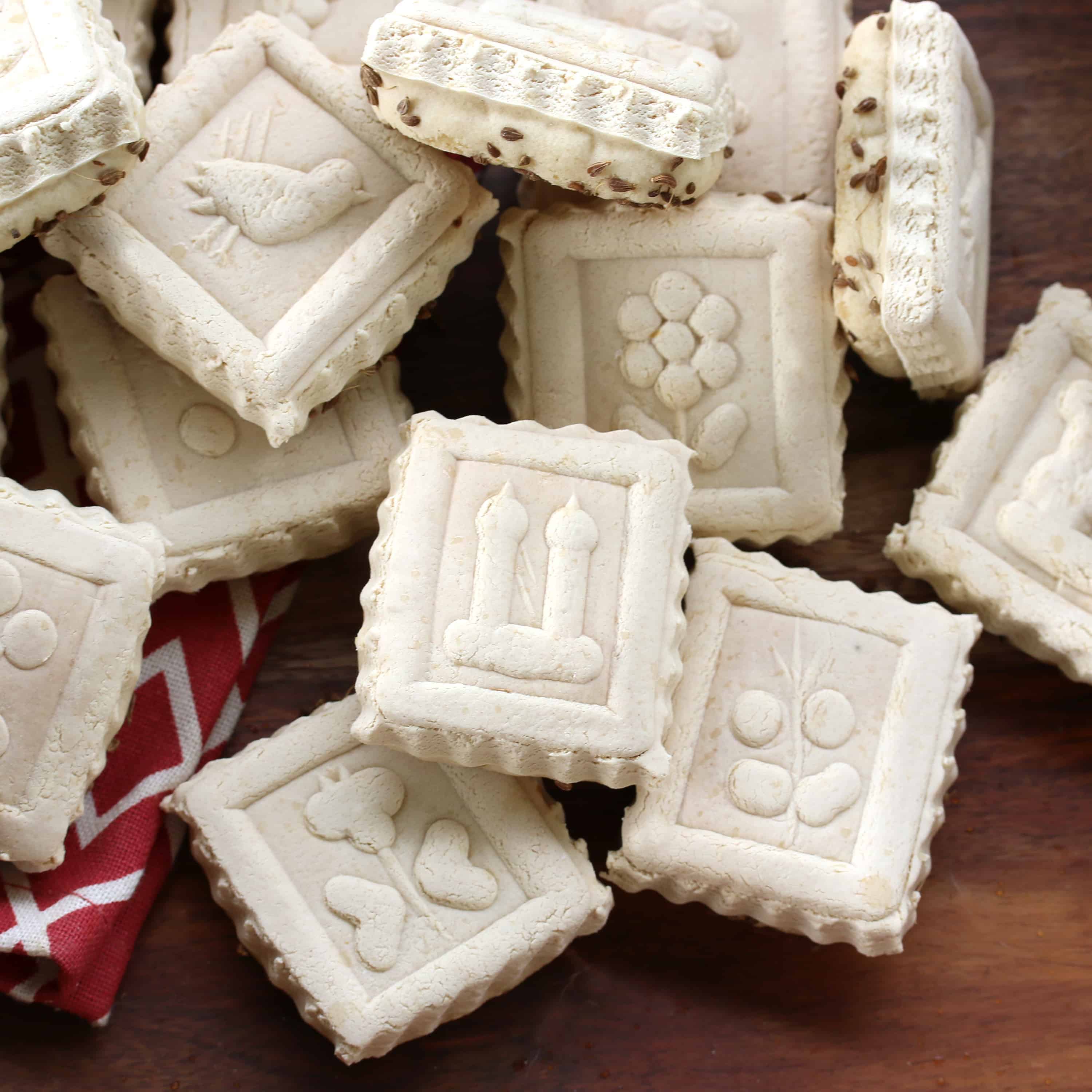
What Are Springlere?
Springerle are traditional German cookies with a very long, very rich history and tradition and come from the Swabia region of southern Germany where I’m from. They’re delicately flavored with anise and are embossed with a variety of designs. Historically made for religious holidays and other special occasions, today they are most commonly made during the Christmas season and for New Year’s though Springerle with flowers, landscapes and other everyday designs remain popular throughout the year. The name “Springerle” translates from German as “little jumpers” because of their behavior of rising or “jumping up” while they’re baking.
Authentic Springerle are made with eggs, sugar, flour, baker’s ammonia, salt and anise. They’re a very low-moisture cookie that are made without any fat. Springerle are very hard cookies that are stored long-term to undergo a period of “ripening” for several weeks as their flavor and texture develops. Over time they develop a delicately crispy-crunchy, shattering exterior and a slightly chewy center. They are traditionally eaten with and dunked in a hot beverage.
The hallmark of Springerle lies in the beauty of their presentation created by special molds used to emboss designs on their surface. Springerle were traditionally made as gifts, as charms for happiness, to give to friends and loved ones on special occasions such as births, weddings, betrothals, during the Christmas season and on New Year’s.
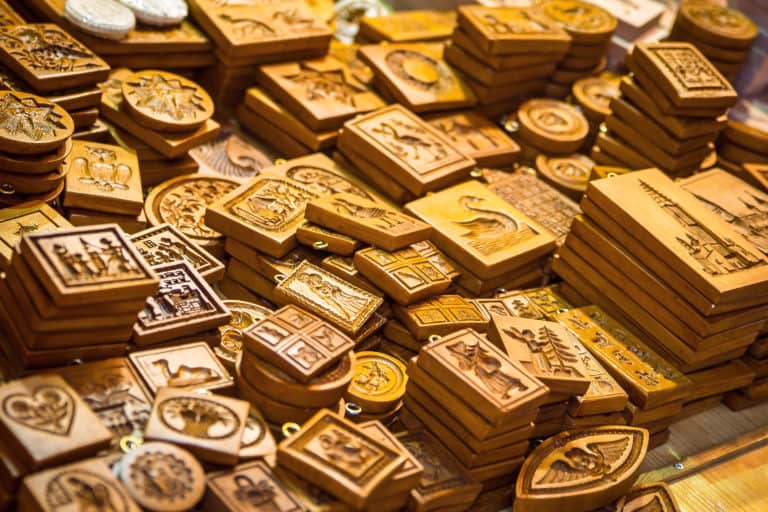
A Brief History of Springerle
These renowned cookies can be traced back to at least the 1300’s to the Swabia region of southern Germany where they were regarded as charms for good luck, happiness and religious observance. Historically Springerle molds were a German baker’s opportunity to show off his woodcarving skills. At that time baking apprentices in Swabia Germany not only had to demonstrate their ability to bake, they also had to carve their own Springerle molds as a kind of rite of passage to becoming a full-fledged, bona fide baker. The more intricate and detailed the mold, the more heralded the baker. These molds were passed down from generation to generation as treasured family heirlooms.
In fact, so prized were these family heirlooms that Germans immigrating to the United States in the 17th and 18th centuries would make space in their luggage just for their Springerle molds.
The themes of the Springerle molds changed throughout the centuries, transitioning from the earlier religious symbols in the 15th century to scenes of gallantry with knights on horseback, then on to the more romantic and highly detailed images of the 19th century with flowers, landscapes, and symbols of love, marriage and friendship. In the 20th century designs included things like Santa Claus, reindeer, and Christmas trees.
You can still buy both simple and elaborate wood-carved Springerle molds in Germany and you can also find antique ones that usually command a hefty price, especially the very detailed ones.
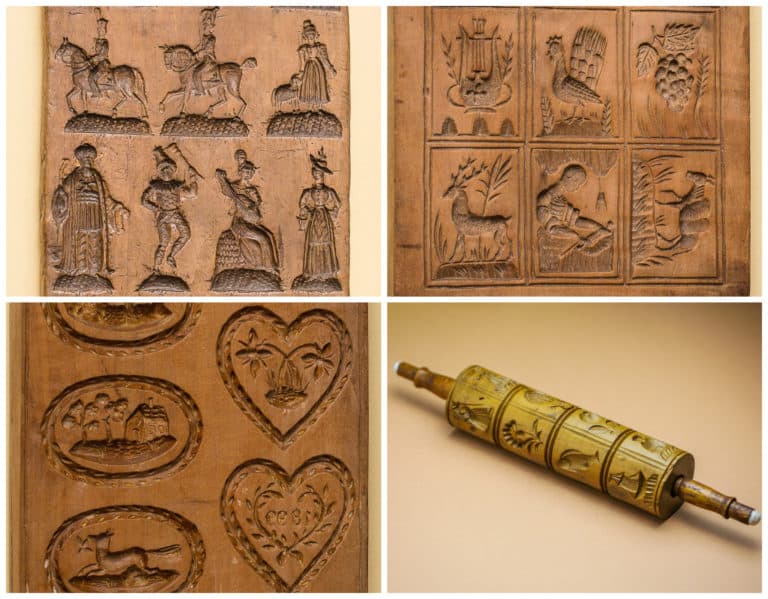
Special Equipment for Making Springerle: Springerle Molds
Trying to find Springerle molds outside of Germany and other European countries that make cookies using molds (eg, Belgium and the Netherlands’ well-known speculoos/speculaas cookies), is very challenging. You can buy antique molds on eBay at a premium price or you can just use whatever you have that’s available. For example, you can use cookie stamps. There are a number of inexpensive ones on the market as well as high quality ones like these cookie stamps from Nordic Ware that are built to last and whose designs are cut deep enough to make a good impression on the cookie (Nordic Ware has multiple designs to choose from). I have three different sets of Nordic Ware cookie stamps.
Pictured below is my Springerle rolling pin that I brought with me from Stuttgart, Germany before I moved to the U.S.. This is the mold that I used in the pictures for this recipe. A Springerle rolling pin is easy to use and you can crank out a ton of Springerle very quickly.
Amazon has a hand-carved Springerle rolling pin that looks similar to mine.
Next we’re going to cover the key aspects to creating truly authentic German Springerle.
Key #1 to Making Authentic Springerle: Baker’s Ammonia
Ammonium bicarbonate, known as baker’s ammonia, is an old-fashioned leavening agent that was commonly used until the 19th century when baking soda and baking powder came onto the scene. If you look through very old cookbooks you’ll find baker’s ammonia in the list of ingredients for specific kinds of baked goods. And while baking powder and baking soda largely replaced and perform a similar function to baker’s ammonia, they are not one and the same. In Europe and the Middle East, for example, some recipes for low-moisture things like crackers and crispy cookies still call for baker’s ammonia because of its unique qualities that baking powder or baking soda cannot replicate. It’s also used (either that or potash) for other types of “flat” baked goods such as German Lebkuchen, Honigkuchen and a German pastry known as Amerikaner, to “loosen” the texture of their crumb.
Springerle are the perfect example of a baked good that really requires the use of baker’s ammonia to get the right results and that’s traditionally what they were always made with.
It doesn’t matter which brand you use, but select one that’s food grade. I’ve been using organic food grade Baker’s Ammonia from Pure Organics.
*Just a note of warning: Baker’s ammonia smells BAD. Really bad. But don’t worry, the smell dissipates during baking.
What is the Difference Between Baker’s Ammonia and Baking Powder/Soda?
Besides having different chemical compositions, they perform differently. While all three are leavening agents, baker’s ammonia creates an effect that baking powder and soda cannot replicate. As the cracker or cookie is baking, the tiny crystals in the ammonium bicarbonate break down and leave tiny air pockets behind in the crumb. The best way to describe the effect is that baker’s ammonia creates a unique honey-combed, porous crumb so that hard baked goods like crackers and cookies/biscuits have a more delicate, crispier, crunchier texture. Baker’s ammonia also contributes to a more even spread of the cookies.
Baker’s ammonia does have a very strong, very unpleasant odor but don’t be put off by that – the odor and taste will dissipate during baking.
In contrast what you normally get with a baked good that has virtually no moisture in it is something you could break your tooth on or could serve as a door stopper. (Think military hard tack from generations ago. Soldiers had to dip it in their coffee in order to make it edible.)
THAT is what you get if you make Springerle without baker’s ammonia: Rock hard, tooth-breaking, door-stopping cookies.
But let’s also be clear on something: Springerle are meant to be hard. And they’re traditionally eaten with a hot beverage for dipping. But the difference is that the baker’s ammonia creates that honey-combing effect that makes them less dense and gives them a more delicate and crunchy crumb.

In addition to the texture advantage of using baker’s ammonia for low-moisture, crispy goods, it also doesn’t leave behind the characteristic soapy flavor that baking powder or soda does.
Cook’s Illustrated’s verdict: “[Baker’s ammonia] works so well, we’d be tempted to use it for crisp baked goods all the time if it were more readily available.” The good news is that it’s readily available online.
Key #2: Authentic Springerle DO NOT Use Butter or Fat of Any Kind. ZERO.
What about the fact that most of the recipes out there on the web don’t call for baker’s ammonia? How do they try to get around the hard-as-a-rock, tooth-breaking factor? They add butter. They add fat in their workaround to soften it up a bit. The result? Shortbread, not Springerle. Different flavor, different texture.
So use the butter to make Scottish Shortbread. But if you want Springerle leave the butter in the fridge. There is no place for butter in traditional Springerle.
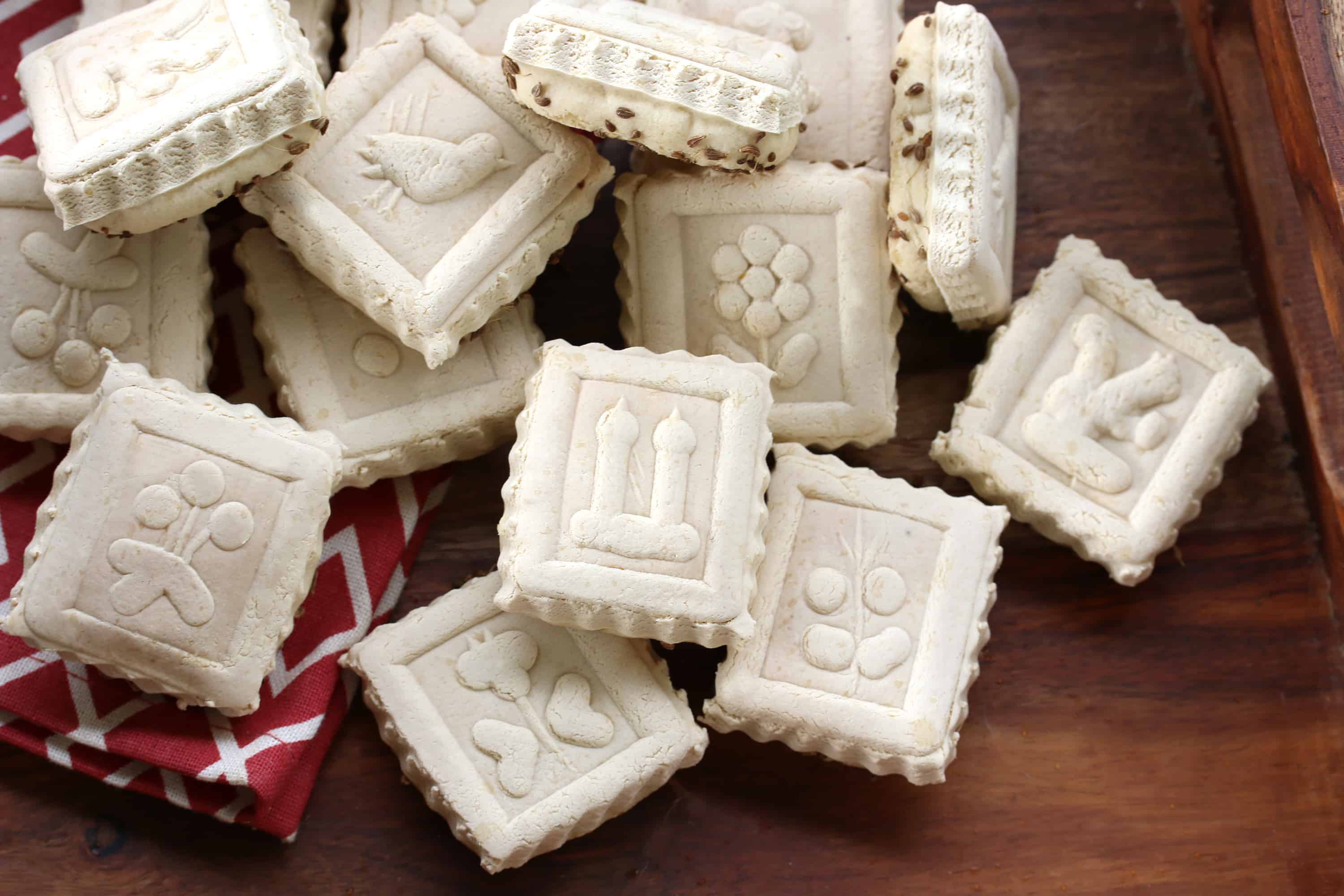
Next let’s talk about the flavor of traditional Springerle.
Being made with nothing but eggs, flour and sugar they really have very little flavor. That’s where the anise comes in. There’s also the addition of the lemon zest which is optional but which we recommend because it contributes a lovely bright contrast and balance to the anise.
Key #3: Fresh Anise Seeds and Quality Pure Anise Oil
Traditionally whole anise seeds are always used. They’re dry roasted in a pan to release their oils and maximize flavor, then they’re strewn across the baking sheet before the Springerle are set on top of them. In addition to the anise seeds many German bakers will also add a few drops of pure anise oil for an added boost in flavor. We also recommend it.
The quality of your anise oil matters. It needs to taste real and it needs to be potent enough so that you only need to add a tiny bit of the oily liquid to achieve the flavor effect. So be sure to use quality 100% pure anise oil.
I use and recommend Lorann’s 100% Pure Anise Oil. It’s very potent and a few drops go a long way.
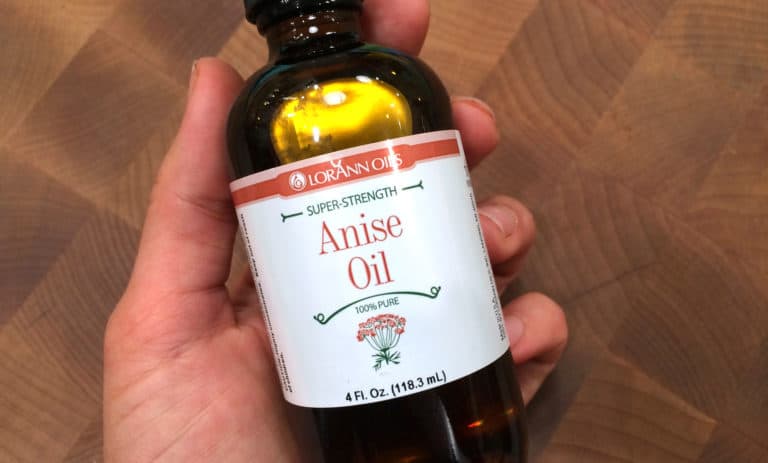
Key #4: Let the Springerle Air Dry For 24 Hours Before Baking Them
The whole purpose of Springerle are to be able to showcase their beautiful embossed designs and if you bake them right away the designs will not hold their shape or form.
In order for the embossed designs to stay in place during baking you need a dough that is super low-moisture to start and then the cookies need to be left to further dry out and develop a hardened crust on the exterior. This way the designs remain stable and unaltered during baking.
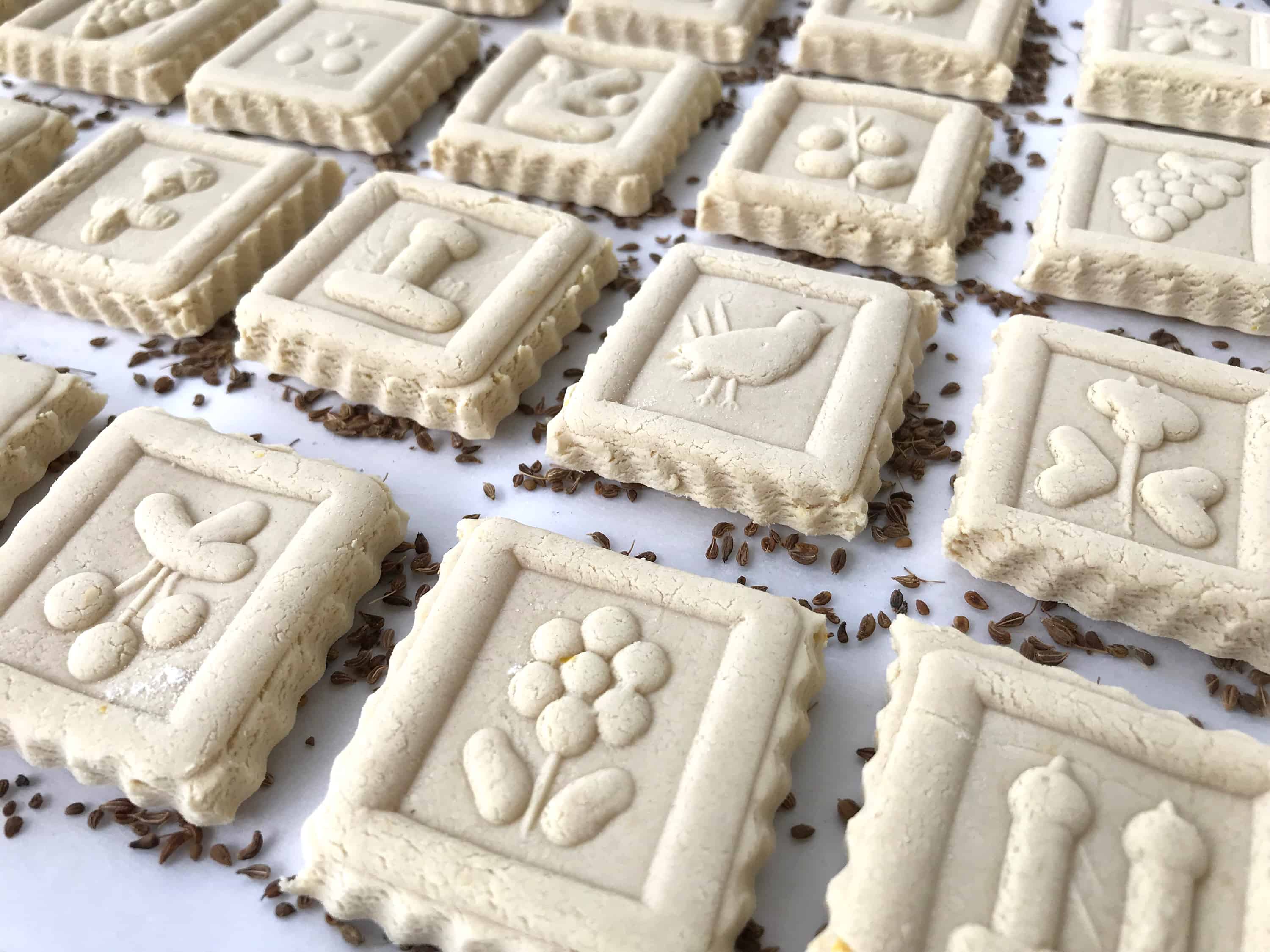
Key #5: Moisten the Bottom of Each Air-Dried Springerle Before Baking Them
The purpose of this step hearkens back to the meaning of their name, Springerle, which means “little jumpers.” Springerle rise in a particular way, creating their characteristic platform on the bottom or “feet” as they call it in Germany. In other words, they “spring up” on their “feet” while baking.
There is an important functional purpose for lightly moistening the bottom of the cookies. Once the cookies have dried for 24 hours they can have uneven moisture spots throughout. This can result in the Springerle rising more quickly on one side than the other, resulting in slanted or lop-sided cookies. To prevent that we lightly and evenly moisten the bottoms by gently pressing the cookie down on a damp cloth. That’s the key for enabling an even-leveled rise.

Authentic Springerle Recipe
Let’s get started!
Place the eggs in a stand mixer with the whisk attachment in place. Beat the eggs until foamy. Add the powdered sugar, a little at a time along with the vanilla sugar (or extract), anise oil and lemon zest (if using).
Once all the powdered sugar has been added continue to beat the mixture for 10 minutes. Yes, that’s 10 full minutes. The batter needs to be very loose and airy. Note: Follow the instructions on your stand mixer to give your machine a rest after the suggested amount of time so as not to overwork your mixer.
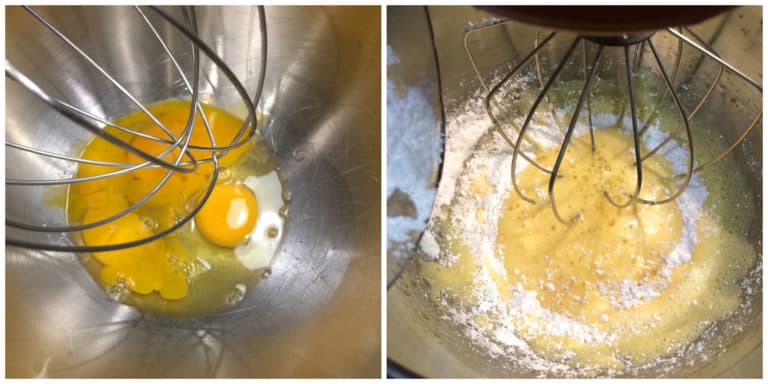
Combine the flour, baker’s ammonia and salt in a bowl. Add HALF of the flour mixture to the wet mixture along with the and beat it for a full 15 minutes.
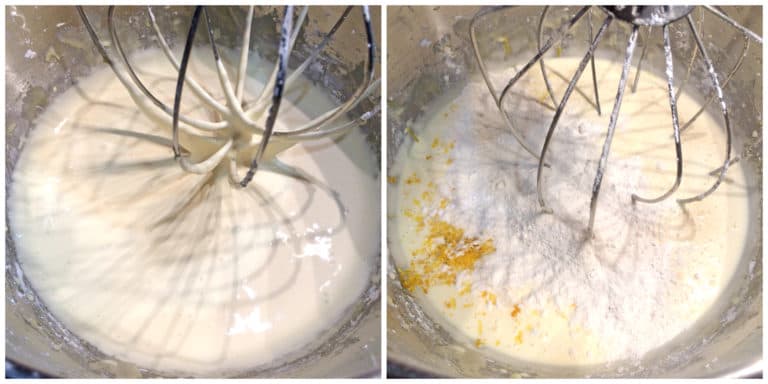
Attach the paddle attachment now. Add the remaining flour and beat for another 5 minutes.
The dough should be very soft but not wet and sticky.
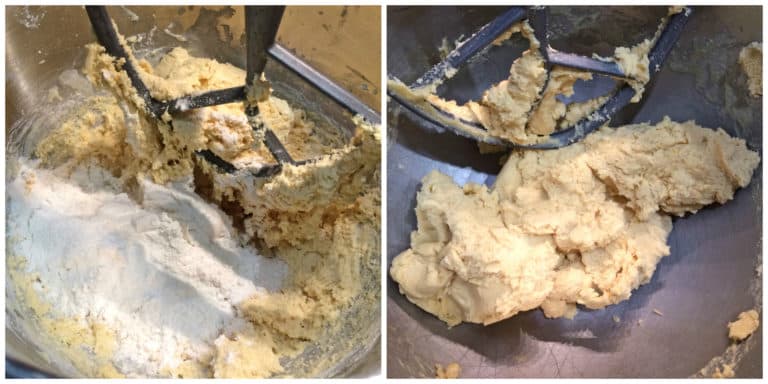
Form the dough into a ball, flatten it to an inch-thick disk, wrap it in plastic wrap and refrigerate for at least an hour or overnight.
The next day roll out the cold dough to about 1/3 inch thick (1 cm) on a floured work surface.
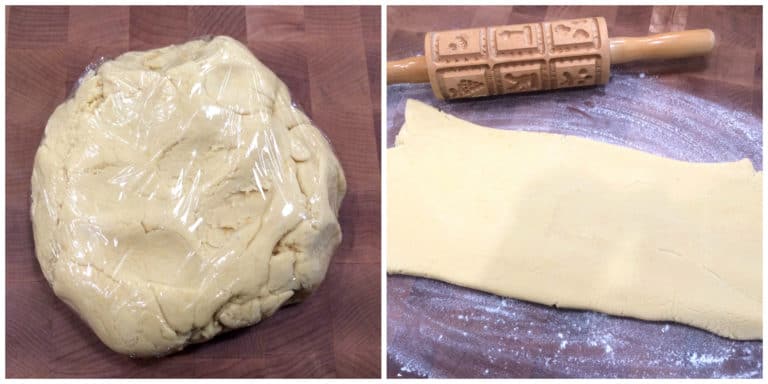
Use your molds or rolling pin to make the shapes and cut them out with sharp knife or pastry cutter. If you’re using molds lightly dust them with flour to prevent the dough from sticking.

Toast the whole anise seeds in a dry pan over medium-high heat until aromatic, being careful not to let them scorch. Place the anise seeds on a lined cookie sheet, spreading them out evenly.

Lay the Springerle on top of the anise seeds on the baking sheet. Let them dry at room temperature for a full 24 hours, longer if you’re in a place with high humidity. The outside of the Springerle should be dry.
Lay a damp towel on the counter and gently press the Springerle down onto it to very lightly and evenly moisten the bottoms. Return the Springerle back to the cookie sheet.
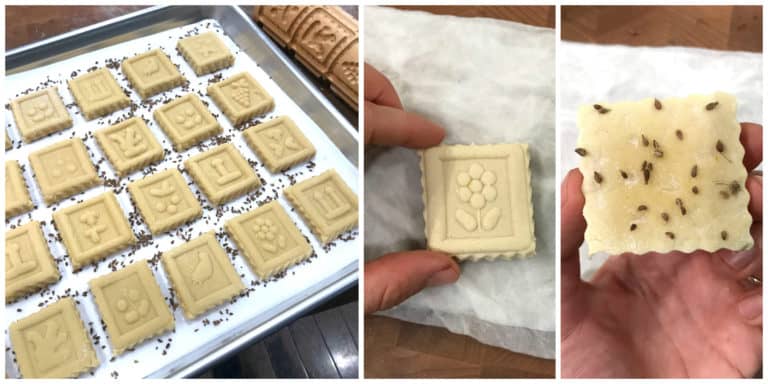
In an oven preheated to 300 degrees F with the rack positioned in the middle, bake the cookies for 20-30 minutes. Do not let the cookies turn golden, they’re supposed to stay very pale, basically the same color as when you put them in the oven.
The Springerle should have risen evenly to create their characteristic “feet” or platform underneath. Let the cookies cool off completely. They will become very hard as they cool.
Springerle are traditionally stored in airtight containers with half of an apple next to them inside the container to create a little bit of moisture to gradually soften the cookies over time. Periodically change out the apple. Once the Springerle have slightly softened up you can remove the apple and then continue storing them in the airtight container waiting for the flavor to develop.

One of the nice things about Springerle is that they’re supposed to be made far in advance. So you can make them weeks before Christmas, set them aside and forget about them, and continue on with your other Christmas preparations.
Most Springerle bakers agree that waiting 3-4 weeks before eating them is best to allow the flavor and texture to develop.
Enjoy these Springerle on their own or, as is tradition, enjoy them with a hot beverage and dip them.
Enjoy!
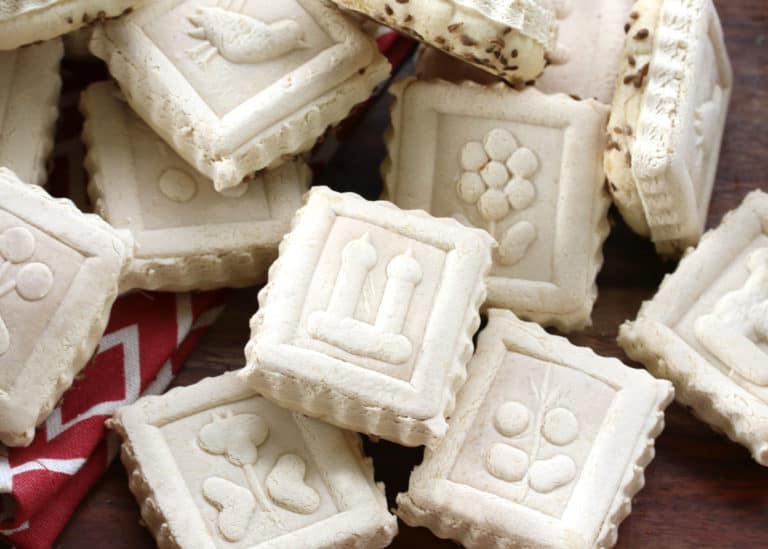
To put your molds and mold rolling pins to further use, be sure to try our traditional Speculoos cookies!
For more incredible German Christmas goodies, be sure to try our:
- Stollen
- Zimtsterne
- Pfeffernüsse
- Lebkuchen
- Marzipan
- Bethmännchen
- Heidesand
- Magenbrot
- Kokosmakronen
- Marzipankartoffeln
- Haselnussmakronen
- Kinderpunsch
as well as our Austrian Vanillekipferl and Linserkekse!

Authentic German Springerle
Ingredients
- 3 large eggs , room temperature (the eggs must be large; if you are using medium add an additional egg)
- 3 cups powdered sugar (confectioner's sugar) (if using cups start with slightly less flour, 2-3 tablespoons, and add the rest as needed)
- 1 teaspoon quality pure vanilla extract (or 2 packets of vanilla sugar)
- 1/4 to 1/2 teaspoon quality 100% pure anise oil (not extract), how much you use depends on how strong of an anise flavor you want.
- 3 cups all-purpose flour (if measuring in cups start with slightly less flour and add the rest as needed if the dough is too soft/sticky)
- 1/4 teaspoon baker's ammonia *slightly less than 1/4 teaspoon (see blog post for explanation about baker's ammonia)
- 1/4 teaspoon salt
- zest of one lemon
- 2 tablespoons whole anise seeds
Instructions
- Place the eggs in a stand mixer with the whisk attachment in place. Beat the eggs until foamy. Add the powdered sugar, a little at a time along with the vanilla extract and anise oil.Once all the powdered sugar has been added continue to beat the mixture for 10 minutes. Yes, that's 10 full minutes, do not reduce the time. The batter needs to be very loose and airy. Note: Follow the instructions on your stand mixer to give your machine a rest after the suggested amount of time so as not to overwork your mixer.
- Combine the flour, baker's ammonia and salt in a bowl. Add HALF of the flour mixture to the wet mixture along with the lemon zest and beat it for a full 15 minutes, do not reduce the time (if the mixture is too dry for your whisk attachment, use the paddle attachment).Attach the paddle attachment, add the remaining flour and beat for another 5 minutes.The dough should be very soft but not wet and sticky. If the dough is too dry or stiff mix in a little more lightly beaten egg.Form the dough into a ball, flatten it to an inch-thick disk, wrap it in plastic wrap and refrigerate for at least an hour or overnight.
- The next day roll out the cold dough to about 1/3 inch thick (1 cm) on a floured work surface (if the dough chilled for several hours and is very firm, let it sit at room temperature until soft enough to work with). Use your molds or rolling pin to make the shapes and cut them out with sharp knife or pastry cutter. If you're using molds lightly dust them with flour to prevent the dough from sticking.Toast the whole anise seeds in a dry pan over medium-high heat until aromatic, being careful not to let them scorch. Place the anise seeds on a lined cookie sheet, spreading them out evenly.Lay the Springerle on top of the anise seeds on the baking sheet. Let them dry at room temperature for a full 24 hours, longer if you're in a place with high humidity. The outside of the Springerle should be dry.
- After the cookies have dried for at least 24 hours, lay a damp towel on the counter and gently press the Springerle down onto it to very lightly and evenly moisten the bottoms. Return the Springerle back to the cookie sheet.In an oven preheated to 300 degrees F with the rack positioned in the middle, bake the cookies for 20-30 minutes. Do not let the cookies turn golden, they're supposed to stay very pale, basically the same color as when you put them in the oven.
- The Springerle should have risen evenly to create their characteristic "feet" or platform underneath. Let the cookies cool off completely. They will become very hard as they cool. Springerle are traditionally stored in airtight containers with half of an apple next to them inside the container to create a little bit of moisture to gradually soften the cookies over time. Periodically change out the apple. Once the Springerle have slightly softened you can remove the apple and then continue storing them in the airtight container waiting for the flavor to develop.
Most Springerle bakers agree that waiting 3-4 weeks before eating them is best to allow the texture and flavor to develop.Enjoy these Springerle on their own or, as is tradition, enjoy them with a hot beverage and dip them.Makes about 34 Springerle depending on their size.
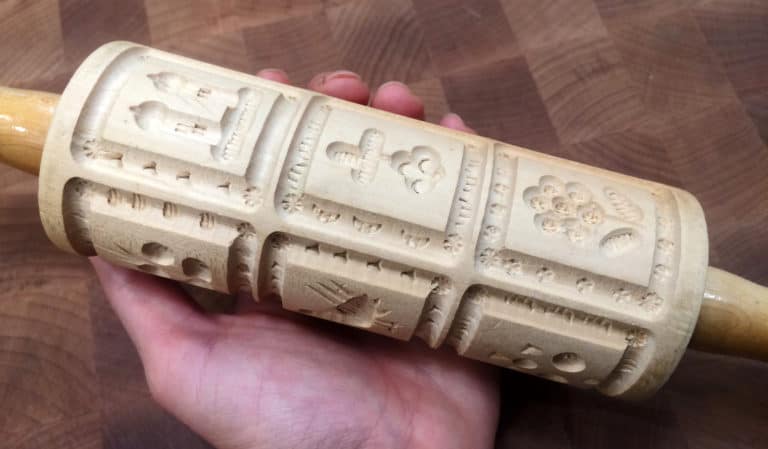
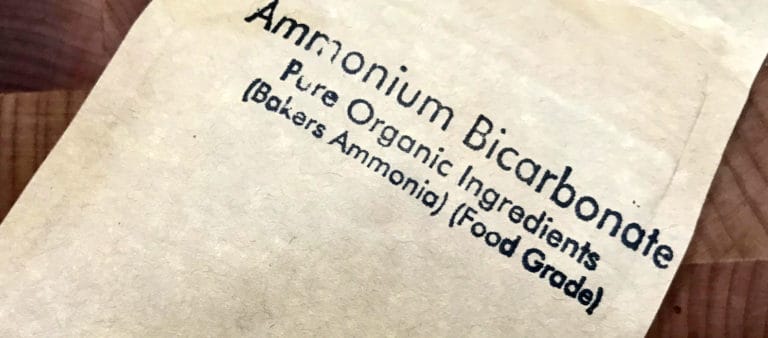
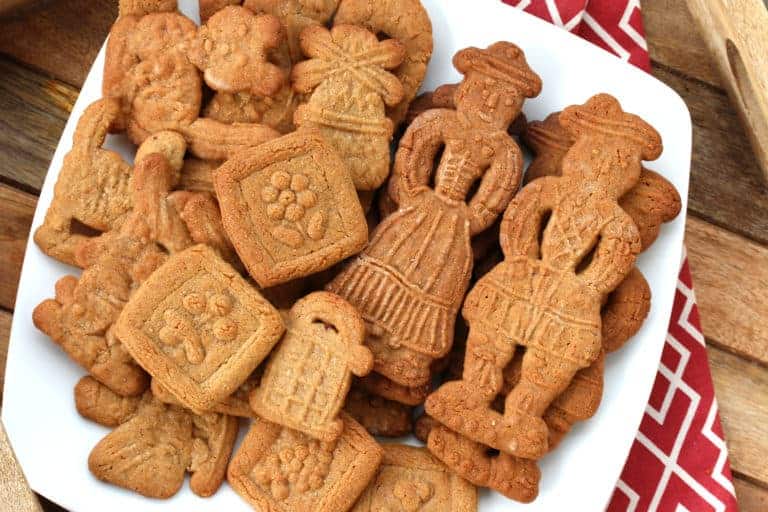
Steve M says
Going to be trying this recipe today. I don’t have the anise oil, but I saw several other recipes that called for the liquid component to use Kirsch. (as a good Schwabe, it feels appropriate)
Would this be an acceptable substitution?
Kimberly @ The Daring Gourmet says
Hi Steve, Kirsch definitely doesn’t belong in traditional Springerle but if that’s the flavor profile you want you can certainly add a small splash. Happy baking!
Chas Grayson says
Hi there! I attempted your recipe twice and both times ended up with a very loose, sticky, tacky dough. I added another 1/2 cup of flour but it did not help. I did add an extra egg as the “large” eggs I had were on the small side. I am not sure if this is the issue. I would love some feedback as this has been a family tradition for some time and I wanted to try yours! Thanks!
Kimberly @ The Daring Gourmet says
Hi Chas, a little bit of egg goes a long way and I definitely think the issue was the extra egg.
Charles Bennett says
Any suggestions amending this recipe for high altitude? Say, 5,400 above sea level?
Jaye says
1st time making these. I have an ex in law who had me hooked on these cookies so I finally decided to try them on my own so our children won’t have to go without something we had become accustomed to over the years. While I haven’t tasted my creation yet(letting the flavor develop atm) I am hopeful they turned out. They look good and the instructions were clear. Only thing I’d like to warn newbies of is that this is not something you can make in a run of the mill mixer. My stand mixers motor burned out the last minute and a half of the process. I did continue to kneed by hand for a couple more minutes to try to ensure the recipe worked out due to the mishap. I’m unsure if a 300Watt mixer would work or if you need something upwards of 550W or greater but I can confirm that one under 300watts WILL NOT survive making this dough. I now need to purchase a new mixer so I’m really hoping these cookies are even more delicious than the ones we use to get this time of year. I live I’m Southern KY USA and for the batch I made I baked on 335 degrees F for 20 mins on the sheet that had cookies crowded onto and at 335F for 15 mins on the 2nd sheet where the cookies were more spaced apart. Both sheets look perfect but the spaced sheet has a bit more of a rise to them(bigger feet I guess). I used an embossed roller and a pizza cutter. I’ll try to remember to update on the taste once I give them as gifts for Christmas.
Jeffrey says
Hi I have been making springerle now for over 40 years
With something not always right. Over the years I have many recipes
And last 10 years the baking was so much work to get it right
SO this year I acted as if I never made them I cleared my brain of everything I’ve been told and used this recipe and I’m in love with the cookies again they don’t stick to my mold the Imprints are perfect baking time works without babysitting it I’m in love with baking these again can’t stop 200 under my belt this year thank you very much
Kimberly @ The Daring Gourmet says
Yay!! Jeffrey, I can’t tell you how happy I am to hear that, thank you so much for the feedback!
Judy says
I followed the recipe accurately. The consistency was just as described.. I chilled the dough over night . When I took it out to roll, it was,dry and brittle. What should I do?
Kimberly @ The Daring Gourmet says
Hi Judy, it sounds like the dough wasn’t wrapped tightly enough and so air was able to get in and dry it out. Unfortunately there’s really not much you can do to correct that at this point other than to just roll it out as best you can and cut it into squares without any designs and proceed with the remaining instructions.
Teresa says
Drat! This exact thing happened to me–I tried to use a tight wrapping of wax paper instead of plastic wrap. Ooops! I was able to salvage the dough by wetting my fingers a few times and working the dough a bit more by hand. But it was a lot of work!
Kimberlee Tanner says
In 2018, I lost everything I owned in the Paradise Camp Fires including all of my recipes and my mother-in-law’s recipes. I collected recipes to hand down to my children because I never had any “family heirloom recipes”. My mother-in-law’s recipes were the closest to family recipes, some coming from her mother-in-law.
The one recipe my husband missed was his mother’s Springerle cookies. Miraculously we still have the rolling pin, just not the recipe. I found this recipe last year, but it took me a while to gather all the unusual ingredients. I’m very glad that I waited and followed the recipe to the hilt. My husband has said that there’s no way he’s waiting 3-4 weeks to eat these, and he’s right. They are almost all gone in 2 days, and just by him. Thank you for the recipe. This has made our holiday very special with fond memories. One caveat. I’m not great with the rolling pin and would love to see a video showing me how to use it. If I press hard to get the mold the cookies are thinner, so that was a bit frustrating. Again, thank you for sharing your recipe. It has made my husband very happy. Kimberlee
Kimberly @ The Daring Gourmet says
Oh my goodness, Kimberlee, I can’t even imagine. Thank you for your comment and feedback, I’m so happy that these Springerle have been a success and that they’ve been providing a nice walk down memory lane. The dough should be very firm and yes, you’ll need to press down fairly firmly in order to get the designs into the dough. So yes, it will flatten the dough some. But if you find you’re having to press “too” hard then it sounds like you’ll need to either add a little less flour or add just a touch more beaten egg to soften the dough a bit more.
Kimberlee says
Thank you for the response. I’m having so much fun making these. My husband said that they are exactly like his mother’s. He was so happy to tell his brother’s, that I’m now making some for them too! Again, thank you for the advice. P.s. I also made your speculaas but without the success of the shaped Santa, even after refrigerating the cutouts. I’m looking forward to mastering the art of cookie molds too! Thanks again. Kimberlee
Amy says
I started a batch of these over the weekend and ran into an unexpected hurdle: after pausing my hand mixer (I don’t have a stand mixer and figured, hey, neither did my great grandmother!) to add the last part of the flour mixture for the last five minutes, it refused to turn back on and only let out the sad smell that said an electrical appliance had gone bad. I think the 25 minutes of straight use wore it out, especially with a rather combative dough. For the last part of mixing, I kneaded it by hand like bread dough. Tonight, when I roll it out, it will be a venture into the unknown. Wish me luck!
Amy says
Well, the results were as mixed as expected when the dough wasn’t properly mixed! When I took it out of the fridge and tried to roll it out, it was fairly brittle and very hard. Getting it smooth and getting any impressions from the mold roller was hard, and I had to rework it several times, and it was tedious and painful and didn’t look like it was going well, so I left it after about a third of the way and let the dough warm. Then when I resumed an hour later, I didn’t work it as much and just left it a little thicker and ended up tossing a good chunk because I didn’t want to rework it again. Let it dry, baked them yesterday, and some came out honestly way better than expected, and some were pretty flat and quickly overcooked. The odd thing is that it’s the ones I’d thought I’d overworked to death that came out well! I guess the extra rolling and squishing and flipping and re-rolling made up for the portion of the last mix I couldn’t do properly. Husband and I tasted a few of the ones I considered middle-ground-looking and they tasted fine, so now they’re all curing!
Barbara Hilbmann says
Made a batch of springerle the inside leaked out. Can still smell ammonia. Are the safe to eat?
Suz says
The cookies needed more time in the oven. If the cookies smell like ammonia, put them back in the oven and check them in 5 minutes.
Tabitha says
This article solves so many mysteries. My Granny and her sister both made springerle at Christmas time. They distinguished them as “hard” and “soft” springerle. Both recipes are lost with the bakers years ago.
After reading this I wonder if my Auntie made hers with baking soda.
Also, a slice of bread works just as well for storage and might have less of the undesirable drawbacks that half an apple could bring.
Shannon Headley says
These turned out really pretty! Although, I made round cookies and they only formed feet in the middle and the tops puffed up so they almost have a football/oval shape. Still tasted good, though!
Rebecca says
I am anxious to try your authentic springerle recipe. I tried another one this week, it had butter in it, and it was ok…. but didn’t get the little “feet” on them. Then, I find out from your post, that it is really a short bread. It was ok, but not great. I want authentic so am anxious to try yours! My question is.. Actually I have two questions: 1. can I dissolve the baker’s ammonia in a tablespoon of milk and add to liquid ingredients, and 2. Can this be made with cake flour? Thanks for your help. I enjoyed reading this and it was very informative and easy to understand!
Kimberly @ The Daring Gourmet says
Hi Rebecca, I’m glad you enjoyed reading this, thank you! Springerle are finicky and so I really recommend following the exact ingredients and procedure because I can’t vouch for how they’ll turn out if you make any substitutes or alterations.
Olga says
Hi! I have just tried this recipe, did everything the way the recipe indicated. While baking in the oven they all leaked out. It looks like the centers leaked out of the cookie and the cookie appeared to be mounted on top of a gooey mess. What could I have done wrong? I would have pasted some photos but I can not find a way to do it here.
Thank you for any advice!
Mike Otten says
I can not wait to try this recipe! I just Amazon’d everything I don’t have (from your links). What a beautiful write up! If you encounter people who think you over-think things, DO NOT LISTEN TO THEM! THEY KNOW NOTHING! ;)
I’m a little nervous about finding out I botched them 3-4 weeks after waiting. ;) Any estimates on the apples? About how often to change, how soon to quit, how ‘slightly softened’? Can I do the same thing with a few, spaced, light mists?
Thank you *so* much for resurrecting these precious things from my childhood!
Kimberly @ The Daring Gourmet says
Thank you so much, Mike! :) If you botched them you’ll know immediately. Once they’re baked if they “look” anything like they’re supposed to, then you succeeded :)
There is no rule at all about how long to wait, but you generally want to wait at least 3-4 weeks after making them to eat them. You can eat them sooner, the flavor just won’t be as developed, and they’ll be even harder. I say “even harder” because even after a month of sitting in the container with the apple they’re still going to be hard, that’s just how Springerle are. Light mists will be too much and you risk either ending up with mushy or moldy cookies. So just stick them in an airtight container with a piece of apple for 3-4 weeks (eyeball the apple to determine when it needs to be swapped – probably about once a week, maybe a little more frequently) and then give them a try. Happy baking and let us know how it goes! :)
Anonymous says
You’re the BEST Kimberly, thanks a million!
Anonymous says
Followed the recipe and all was going well. I weighed the ingredients and got a perfectly workable dough. I dried my cookies over night with no hassle. However I took out my cookies after 22 minutes to find them bursting at the bottom. The pattern held, but it certainly wasn’t as attractive as I had hoped. I did a little research and found that most other springerle recipes suggest half the cook time. I still have a little dough left over, so I’ll try again with a halved baking time and see if I get a better result. I’m kicking myself for not testing a cookie first. Lesson learned
Teressa says
Hi Anon,
This is a very nice write-up about Springerle. I have been making them (perfectly and imperfectly) for years. 300 is too high for smaller/med size cookies. 200-225 is what works if you don’t want the feet falling over from the bottoms or have them browning before the cookie is baked.
You have to watch over them even at the lower temps. I’ve found 25 minutes at 225 may not be long enough. But it depends on the size of the cookie. Sometimes it’s been 35 minutes. Dampening the bottoms as suggested before baking may be helpful too. The old recipes often called for a ‘slow’ oven and I’ve never had any luck with baking them over 250 degrees. Better luck next time!